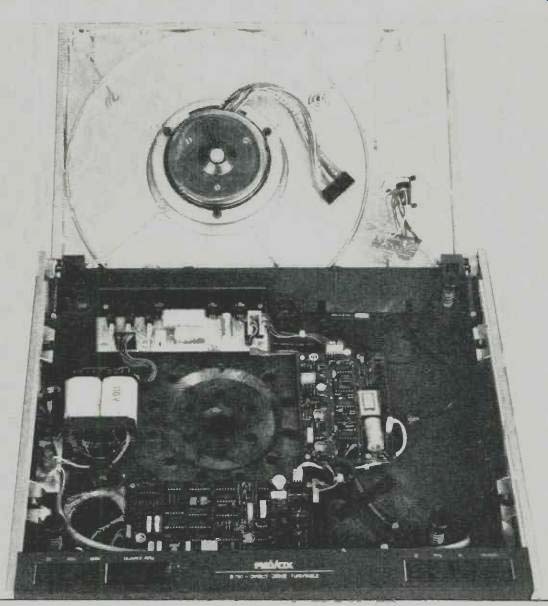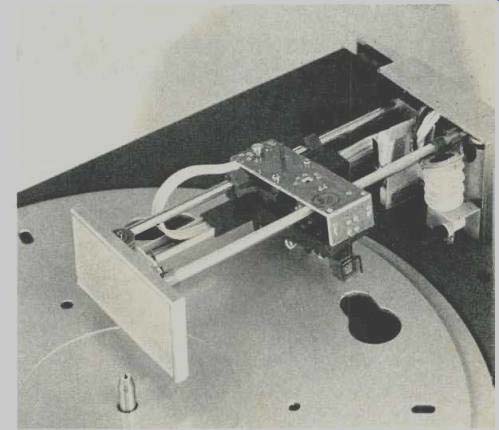
MANUFACTURER'S SPECIFICATIONS:
Drive: Quartz-controlled, direct.
Speeds: 33 and 45 rpm.
Speed Accuracy: Better than 0.01 percent (DIN 45 507).
Manual Speed Variation: ±7 percent.
Speed Indication: Four-digit LED readout.
Wow & Flutter: Better than 0.05 percent (DIN 45 507).
Braking Time: Better than 1.5 seconds.
Rumble: Better than 68 dB (DIN B).
Dimensions: 18-7/8. (45.7 cm) W x 15-in. (38.1 cm) D x 5 1/2-in (14 cm) H.
Price: $899.00.

As I'm sure most of our readers know--when a master record is made the cutter head travels across the lacquer in a straight line; it doesn't move in an arc like most tonearms and introduce a tracking error. However, by careful design, the use of an optimum-length tonearm, offset headshell mounting, etc., this tracking error can be reduced to almost the vanishing point. Even so, the potential for improvement, however microscopic, has proved a challenge for design engineers who have come up with various means to duplicate the original cutting motion.
In the past we have seen complex articulated twin arms from Burne-James and Garrard, as well as straight-line carrier models from Marantz, B&O, Schlumberger, and Rabco, all with varying degrees of success. It is known that Sony has a sophisticated model in the lab stage, and now Revox has entered the arena with the B 790, a nicely styled unit made with typical Swiss precision. The turntable measures 18-in. long by 15-in. deep by 5 1/2-in. high, while the motor is a quartz-controlled, direct-drive model with speed correction signals generated by a 200-cog pulse wheel and Hall-effect devices. The tonearm carrier consists of an assembly measuring 7 3/4-in. long which swings radially over the record to be played. The phono cartridge is mounted on a small arm, less than 2-in. in length, which slides along a metal bar on the assembly. Tracking is controlled by a photo-optical sensor and servo-operated d.c. motor. The arm lowering system is electronically controlled by pneumatic damping, and the muting circuit is switched off as soon as the stylus touches the record.
All controls are located in the front and are accessible even when the dustcover is closed-a design trend which is becoming more popular. On the extreme left of the turntable, there is a group of three rectangular pushbuttons; two for speed change, while the third, marked Variable, disconnects the reference frequency control and allows the speed variation of +/- 7 percent. The speed control is in the form of a thumbwheel mounted next to a digital display to the right of the pushbuttons, and it should be mentioned that the quartz-lock mechanism is always operative. On the right hand side of the unit is another group of pushbuttons: Two operate a motor which sends the phono cartridge right-to-left or left-to-right (yes, the cartridge is automatically lifted from the record) and number three is the cue control. Finally, a large button at the end is the power On/Off switch.
The unit is nicely finished in a combination of charcoal black, gray, and silver (matching other Revox products) and stands upon four solid feet. The motor and tonearm are mounted to a heavy, diecast top plate which is spring isolated from the base to prevent acoustic feedback.

Measurements
Our sample came fitted with an Ortofon M20E phono cartridge but, as Revox states, the unit is also available without a cartridge and, of course, mounting instructions will be sup plied. Stylus force is controlled by a small screw, and the quoted range is from 0.5 to 2.0 grams. Because of the small clearance between the stylus and the turntable, it wasn't easy to use a gauge to measure the actual force being applied, but it appeared that the force setting on the unit supplied was just over 1 gram. However, a stylus force gauge is supplied with the phono cartridge kit to allow the proper mounting of any cartridge, with the possible exception of the older, larger moving-coil cartridges, in the tonearm. There is no anti-skating control to adjust- one of the advantages of tangential tracking.
Wow and flutter were measured first and the combined figure was an excellent 0.04 percent (DIN 45 507). Rumble was -63 dB (ARLL) which is better than average. Variable speed control gave a range of +6.5 percent to -7.5 percent, more than adequate.
Listening and Use Tests
In operation, the record is placed on the turntable and the tonearm assembly is swung over it- the stylus passing over a brush on the way to the disc. The motor is switched on automatically and as soon as the Cue button is depressed, the stylus is gently lowered to the record. If desired, one of the transit buttons can be pressed and the cartridge will move to another position. At the end of the record, the tonearm returns to its "up" position above the run-in groove and the motor is switched off. When the tonearm carrier is swung away from the record, the cue-control system is disconnected so there is no chance of accidentally damaging the stylus.
The main problem with straight-line or tangential tracking has to do with the maintenance of accurate groove positioning, and the Revox B 790 uses an ingenious method to solve it. Two photo diodes receive infrared light from an LED through a slot in the tonearm. If the arm is displaced, even slightly, to one side, the photo diodes receive an asymmetrical amount of light, and the resulting signals are passed onto the servo system which controls the regulating d.c. motor driving the tonearm cradle. I must say that this system works very well, and Revox is to be congratulated.
How did the turntable system sound? (Yes, the turntable can affect sound.) Well, in this case the results are governed by the phono cartridge, and the M 20E supplied is certainly not the best choice in the Ortofon line. In my opinion, the MC 30 moving-coil model would have been more suitable.
Even so, the M 20E gave a good account of itself tracking all bands of the Shure ERA III test record with no difficulty. The impressive 36 Hz drum in the Telarc recording of Hoist's Suite Number I (Telarc digital 5038) was also reproduced with no groove jumping or distortion-quite a severe test.
The unit seemed reasonably free from acoustic feedback problems due to the efficient suspension system. The only possibility for vibration might be from the top plate caused by airborne sound if the turntable is placed too close to the loudspeakers.
Overall, the unit is well designed and constructed, and it should give many years of faithful service. The only problems would seem to be the smaller than usual cartridge clearance which could cause problems with warped records--not mis-tracking, but a thumping or scraping noise.
-George W. Tillett
(Source: Audio magazine, Jun. 1979)
Also see:
Revolver Turntable, Standard Arm, and Bullet Cartridge (Equip. Profile, Apr. 1989)
Ariston Forte Turntable and Enigma Tonearm (Dec. 1988)
Dual CS 5000 Turntable and Ortofon X3-MC Cartridge (Nov. 1988)
Thorens TD 320 Turntable and TP 16 MK III Tonearm (Mar. 1987)
= = = =